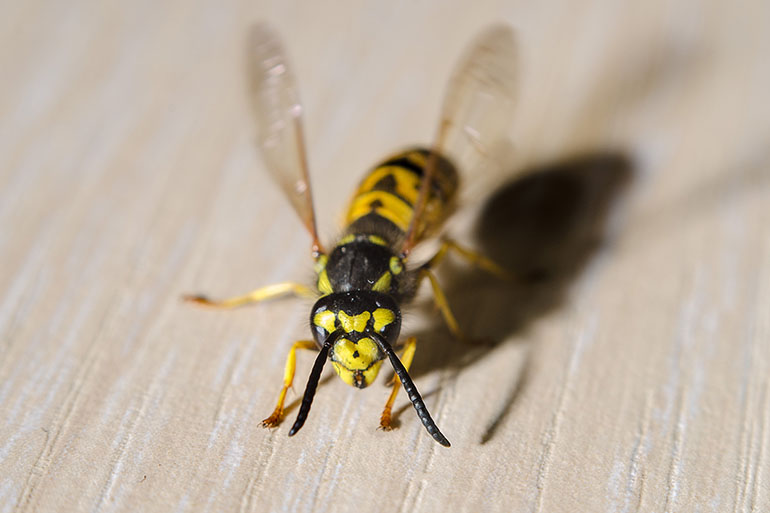As summer begins, signaling peak time for insect stings, allergists across the U.S. are warning of a shortage of a little-known but crucial product — honeybee, hornet and wasp venom extracts used in shots that prevent life-threatening reactions.
Supplies of the extracts — which are made from venom gathered by hand from millions of individual insects — have been scarce since October. That’s when one of two manufacturers in the U.S. shut down production after contamination problems. Doctors say they hope the situation will be resolved, but that’s not likely before next year. For now, they’re rationing doses for patients who need them most.
“It’s going to be a rough summer,” said Dr. David Golden, an allergy expert and associate professor of medicine at Johns Hopkins University.
Golden estimates he’s seen a 25 to 35 percent drop in the supply of venom extracts aimed at preventing dozens, perhaps hundreds, of deaths in the U.S. each year. Between 1 and 3 percent of the country’s adult population — up to 7.4 million people — may have systemic reactions to insect stings, and a smaller proportion have life-threatening responses, experts say.
Most of those vulnerable people carry portable epinephrine — often EpiPens — to quickly counteract symptoms. But a smaller number use what’s known as venom immunotherapy, or VIT, to dramatically reduce the risk of reactions. The treatment, authorized for nearly 40 years, injects small doses of venom under the skin to reduce sensitivity to the allergens that can trigger dangerous symptoms.
“It’s one of the few things that allergists do that actually save lives,” said Dr. Stephen Tilles, a Seattle allergist who is president of the American College of Allergy, Asthma and Immunology (ACAAI). “It’s about 98 percent effective.”
The shortage started last fall, when ALK Laboratories of Denmark shut down production of six types of venom proteins — honeybee, wasp, white-faced hornet, yellow hornet, yellow jacket and “mixed vespid,” a cocktail of venoms.
The move followed a 2016 letter from the Food and Drug Administration citing problems with microbiological contamination. ALK officials didn’t respond to requests for comment.
That left only Jubilant HollisterStier, a Spokane, Wash., company that also produces venom extracts. HollisterStier ramped up manufacturing, Golden said, but the firm couldn’t supply enough venom extract fast enough to avoid a shortage. Firm officials declined to comment.
“Most allergists are having to seriously limit what they use,” Golden said. “We’re trying to stretch the venom that we have.”
This spring, Golden and colleagues issued recommended guidelines for rationing venom during the shortage. They called for spacing out doses at longer intervals, cutting maintenance doses, minimizing venom waste — and stopping treatment for patients at lowest risk for severe reactions.
So far, the plan appears to have worked, said Dr. Sandra Hong, an allergist with the Cleveland Clinic. Most patients do fine with shots at longer intervals; instead of every four weeks, they get them every three months. And after three to five years of treatment, many can be weaned from the venom with no ill effects.
“With all the things the allergists have done, it has decreased the shortage,” Hong said.
There have been a few reports of allergists who couldn’t get supplies of venom, and patients who couldn’t get the product, which costs about $70 for induction doses and about $20 for each maintenance dose. So far, there are no known cases of adverse events in patients who couldn’t get shots. There’s also no sign of the skyrocketing drug prices that have occurred with other products in short supply.
Still, allergists worked to ensure that patients at the highest risk weren’t harmed. That includes people like Ciro DeMarco, 58, a retired machinist from Moxee, Wash.
DeMarco nearly died in 1983 after he was stung by a honeybee while riding a motorcycle near a river in rural eastern Washington.
“I started feeling real strange,” he recalled. “I stopped the motorcycle and sat down. All of a sudden, I had no sight and I was almost unconscious.”
He lived in fear of another sting until about 10 years ago, when he learned about VIT. Now he gets regular venom shots every three months and takes over-the-counter allergy medications before he climbs onto his Harley-Davidson. He’s relieved that the shortage hasn’t affected his supply.
“Every spring I worry about it,” he said. “But I’m not going to quit riding just in case I get stung.”
ALK Laboratories may resume production soon and the shortage could be eased in coming months. Once the supply question is resolved, Golden said, he hopes to tackle a larger issue: lack of VIT awareness among people who’ve had a bad reaction to an insect sting.
“No more than 10 percent of the affected people have sought medical attention,” he said. “Problem No. 1 is that many people, including doctors, don’t know venom immunotherapy exists.”








